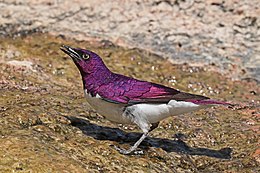| Violet-backed starling | |
|---|---|

| |
| Male | |

| |
| Female both C. l. verreauxi Damaraland, Namibia | |
| Conservation status | |
 Least Concern (IUCN 3.1) | |
| Scientific classification | |
| Domain: | Eukaryota |
| Kingdom: | Animalia |
| Phylum: | Chordata |
| Class: | Aves |
| Order: | Passeriformes |
| Family: | Sturnidae |
| Genus: | Cinnyricinclus Lesson, 1840 |
| Species: | C. leucogaster |
| Binomial name | |
| Cinnyricinclus leucogaster (Boddaert, 1783) | |
| Synonyms | |
|
Turdus leucogaster Boddaert, 1783 | |
The violet-backed starling (Cinnyricinclus leucogaster), also known as the plum-coloured starling or amethyst starling, or Ndambamukula in the Luvenḓa (Venḓa) language, is a relatively small species (17 cm) of starling in the family Sturnidae. It is the only member of the genus Cinnyricinclus. This strongly sexually dimorphic species is found widely in the woodlands and savannah forest edges of mainland sub-Saharan Africa. It is rarely seen on the ground, but instead found in trees and other locations away from the ground.
Taxonomy
The violet-backed starling was described by the French polymath Georges-Louis Leclerc, Comte de Buffon in 1775 in his Histoire Naturelle des Oiseaux. The bird was also illustrated in a hand-coloured plate engraved by François-Nicolas Martinet in the Planches Enluminées D'Histoire Naturelle, which was produced under the supervision of Edme-Louis Daubenton to accompany Buffon's text. Neither the plate caption nor Buffon's description included a scientific name but in 1783 the Dutch naturalist Pieter Boddaert coined the binomial name Turdus leucogaster in his catalogue of the Planches Enluminées. The type locality is Benin in West Africa. The violet-backed starling is now the only species placed in the genus Cinnyricinclus that was introduced by the French naturalist René Lesson in 1840. The violet-backed starling was designated as the type species by the English naturalist George Robert Gray in 1855. The genus name is combines Cinnyris, a genus of sunbirds that had been introduced by the French naturalist Georges Cuvier in 1816, and the Neo-Latin cinclus meaning "thrush". The specific leucogaster is from the Ancient Greek leukos meaning "white" and gastēr meaning "belly".
Subspecies
Three subspecies are recognised:
- C. l. leucogaster (Boddaert, 1783) – Senegal and Gambia to Ethiopia, Kenya and Tanzania
- C. l. arabicus Grant, CHB & Mackworth-Praed, 1942 – east Sudan to northwest Somalia and the Arabian Peninsula
- C. l. verreauxi (Finsch & Hartlaub, 1870) – south DR Congo to west Tanzania south to Botswana, northeast South Africa and Mozambique
Description
The violet-backed starling is a sexually dimorphic species with adults reaching a length of about 18 cm (7 in). The male has an iridescent violet head and back and pure white underparts. The female has a thrush-like appearance with brown, boldly-streaked upper parts and white, heavily-streaked underparts. Both sexes have yellow irises and black bills and legs.
Distribution and habitat
The violet-backed starling is a common bird in Sub-Saharan Africa, occurring in most locations with the exception of the dense rainforest of the Congo Basin, and the more arid parts of southwestern Africa. It is found in open woodland, gallery forests, forest verges and clearings. In the Chyulu Hills of Kenya, it occurs at altitudes up to 2,100 m (6,900 ft).
Behaviour
The diet of the violet-backed starling includes fruits, seeds and arthropods. It sometimes hawks for insects in a manner similar to flycatchers. It largely feeds in the canopy, seldom foraging on the ground. The nest is usually located in a crevice in a tree within a few metres of the ground. Nesting material includes green leaves and dung. The female will incubate the clutch of two to four eggs, which are pale blue with reddish/brown spots, for 12–14 days. The male will help feed chicks until they fledge after about 21 days.
Gallery
-
 Male violet-backed starling, Pilanesberg NP, South Africa
Male violet-backed starling, Pilanesberg NP, South Africa
-
 Female violet-backed starling, Pilanesberg NP, South Africa
Female violet-backed starling, Pilanesberg NP, South Africa
References
- BirdLife International (2018). "Cinnyricinclus leucogaster". IUCN Red List of Threatened Species. 2018: e.T22710791A131959396. doi:10.2305/IUCN.UK.2018-2.RLTS.T22710791A131959396.en. Retrieved 15 November 2021.
- "Violet-backed Starling Cinnyricinclus leucogaster (Boddaert, 1783)". Avibase - The World Bird Database. Denis LePage. Retrieved 5 December 2020.
- Buffon, Georges-Louis Leclerc de (1775). "Le merle violet à ventre blanc de Juida". Histoire Naturelle des Oiseaux (in French). Vol. 6. Paris: De L'Imprimerie Royale. pp. 104–105.
- Buffon, Georges-Louis Leclerc de; Martinet, François-Nicolas; Daubenton, Edme-Louis; Daubenton, Louis-Jean-Marie (1765–1783). "Merle violet à ventre blanc, de Juida". Planches Enluminées D'Histoire Naturelle. Vol. 7. Paris: De L'Imprimerie Royale. Plate 648 Fig. 1.
- Boddaert, Pieter (1783). Table des planches enluminéez d'histoire naturelle de M. D'Aubenton : avec les denominations de M.M. de Buffon, Brisson, Edwards, Linnaeus et Latham, precedé d'une notice des principaux ouvrages zoologiques enluminés (in French). Utrecht. p. 39, Number 648 Fig. 1.
- Mayr, Ernst; Greenway, James C. Jr, eds. (1962). Check-list of Birds of the World. Vol. 15. Cambridge, Massachusetts: Museum of Comparative Zoology. p. 98.
- Lesson, René (1840). "Notices ornithologiques". Revue Zoologique. 3: 261–275 .
- ^ Gill, Frank; Donsker, David, eds. (2019). "Nuthatches, Wallcreeper, treecreepers, mockingbirds, starlings, oxpeckers". IOC World Bird List Version 9.2. International Ornithologists' Union. Retrieved 1 September 2019.
- Gray, George Robert (1855). Catalogue of the Genera and Subgenera of Birds Contained in the British Museum. London: British Museum. p. 66.
- Jobling, James A. (2010). The Helm Dictionary of Scientific Bird Names. London: Christopher Helm. pp. 108, 223. ISBN 978-1-4081-2501-4.
- ^ Craig, Adrian; Feare, Chris (2010). Starlings and Mynas. Bloomsbury Publishing. pp. 224–227. ISBN 978-1-4081-3522-8.
External links
- "Plumcoloured Starling". The Atlas of Southern African Birds.
- Xeno-canto: audio recordings of the violet-backed starling
| Taxon identifiers | |
|---|---|
| Cinnyricinclus leucogaster |
|